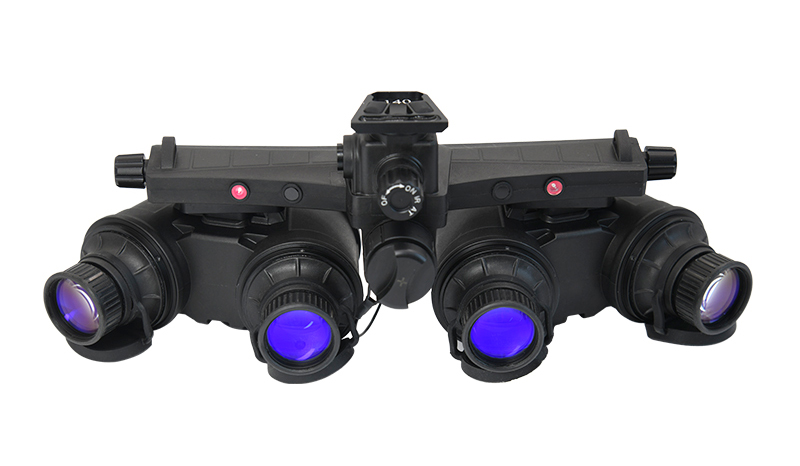December 21, 2024By: MH TECHView: 176

1. Field of view
Binocular night vision goggles (PVS-31): Usually the field of view is about 40° - 60°, which can provide a relatively wide field of view, but still have certain limitations. For example, when conducting a large-area search or needing to quickly observe the surrounding environment, you may need to frequently turn your head to view the situation in different directions.
Four-eye night vision goggles (GPNVG-18): One of its biggest advantages is that it has a wider field of view. The horizontal field of view can reach 80° or even wider, close to or exceeding the normal field of view of the human eye. For example, the field of view of some advanced four-eye night vision devices can reach 120° - 126°. This allows users to observe a wider range of scenes without turning their heads or only turning their heads slightly, greatly enhancing the situational awareness ability, and is very practical in scenes such as battlefield observation in military operations and large-area inspections in security monitoring.
2. Imaging effect
Binocular night vision device (PVS-31): The imaging quality mainly depends on its optical system and image intensifier and other components. Generally, it can provide a good stereoscopic visual effect, allowing users to perceive the depth and distance of objects, and can also generate clear images through reasonable optical design and signal processing technology. However, due to only two observation channels, the ability to capture details in some complex environments may be relatively limited.
Four-eye night vision device (GPNVG-18): Through four independent observation channels, it can collect more light and information, and often provide higher resolution and clearer imaging effects. Some four-eye night vision devices also use more advanced image processing technology and high-performance image intensifier tubes, which can present detailed and realistic images under extremely low illumination, and even achieve full-color night vision imaging, and perform better in identifying targets and environmental details.
3. Functional diversity
Binocular night vision device (PVS-31): The functions are mainly concentrated in basic night vision observation. Some products may be equipped with some simple auxiliary functions, such as brightness adjustment, focal length adjustment, simple photo or video function, etc., to meet general use needs.
Four-eye night vision device (GPNVG-18): In addition to basic night vision functions, more advanced functions are usually integrated. For example, some four-eye night vision devices have multiple observation modes, such as white light mode, infrared mode, contour mode, etc., which can be flexibly switched according to different environments and tasks; they may also be equipped with a diopter adjustment function to adapt to the vision differences of different users, and may also have infrared indicator lights and environmental indicator lights, etc., to provide additional lighting or warning information in complex environments.
4. Wearing experience and weight
Binocular night vision device (PVS-31): The structure is relatively simple, and the weight is generally around 500-1000 grams, which is relatively light to wear. Its design is also more ergonomic, which can better balance the weight distribution on the head and reduce discomfort, but it may still cause head and neck fatigue after long-term use.
Four-eye night vision device (GPNVG-18): Due to the addition of observation channels and more functional components, its structure is more complex and the weight may be heavier. However, with the advancement of technology, many four-eye night vision devices are now also using lightweight materials and optimized designs to reduce the overall weight. For example, the weight of some products can be controlled at around 1000 grams or even lighter to improve wearing comfort and reduce the burden caused by long-term wearing.
5. Price and application areas
Binocular night vision device (PVS-31): The price range is wide, ranging from a few thousand yuan to tens of thousands of yuan. Compared with the four-eye night vision device, the price is relatively low. It is suitable for civil security, outdoor adventures, general military observation and other fields, and can meet most basic night vision needs.
Four-eye night vision goggles (GPNVG-18): Due to its advanced technology, complex structure and more powerful functions, the price is usually higher. It is generally used in high-end military applications, special operations, professional security monitoring and other fields with extremely high requirements on field of view, imaging quality and functions, such as special operations missions in complex terrain at night, security scenes with high-precision monitoring of large areas, etc.